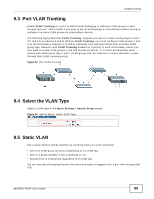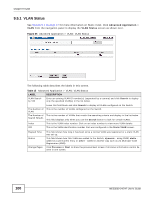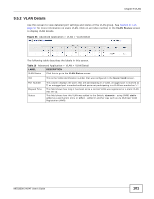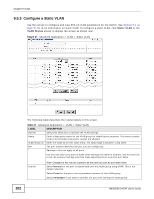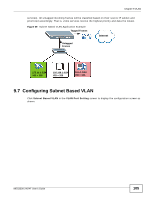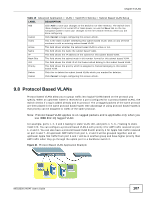ZyXEL MES3500-24F User Guide - Page 104
Subnet Based VLANs
 |
View all ZyXEL MES3500-24F manuals
Add to My Manuals
Save this manual to your list of manuals |
Page 104 highlights
Chapter 9 VLAN Table 18 Advanced Application > VLAN > VLAN Port Setting (continued) LABEL * DESCRIPTION Settings in this row apply to all ports. Use this row only if you want to make some settings the same for all ports. Use this row first to set the common settings and then make adjustments on a port-by-port basis. Ingress Check Note: Changes in this row are copied to all the ports as soon as you make them. If this check box is selected for a port, the Switch discards incoming frames for VLANs that do not include this port in its member set. PVID Clear this check box to disable ingress filtering. A PVID (Port VLAN ID) is a tag that adds to incoming untagged frames received on a port so that the frames are forwarded to the VLAN group that the tag defines. GVRP Acceptable Frame Type Enter a number between 1and 4094 as the port VLAN ID. Select this check box to allow GVRP on this port. Specify the type of frames allowed on a port. Choices are All, Tag Only and Untag Only. Select All from the drop-down list box to accept all untagged or tagged frames on this port. This is the default setting. Select Tag Only to accept only tagged frames on this port. All untagged frames will be dropped. VLAN Trunking Isolation Apply Cancel Select Untag Only to accept only untagged frames on this port. All tagged frames will be dropped. Enable VLAN Trunking on ports connected to other switches or routers (but not ports directly connected to end users) to allow frames belonging to unknown VLAN groups to pass through the Switch. Select this to allows this port to communicate only with the CPU management port and the ports on which the isolation feature is not enabled. Click Apply to save your changes to the Switch's run-time memory. The Switch loses these changes if it is turned off or loses power, so use the Save link on the top navigation panel to save your changes to the non-volatile memory when you are done configuring. Click Cancel to begin configuring this screen afresh. 9.6 Subnet Based VLANs Subnet based VLANs allow you to group traffic into logical VLANs based on the source IP subnet you specify. When a frame is received on a port, the Switch checks if a tag is added already and the IP subnet it came from. The untagged packets from the same IP subnet are then placed in the same subnet based VLAN. One advantage of using subnet based VLANs is that priority can be assigned to traffic from the same IP subnet. For example, an ISP (Internet Service Provider) may divide different types of services it provides to customers into different IP subnets. Traffic for voice services is designated for IP subnet 172.16.1.0/24, video for 192.168.1.0/24 and data for 10.1.1.0/24. The Switch can then be configured to group incoming traffic based on the source IP subnet of incoming frames. You can then configure a subnet based VLAN with priority 6 and VID of 100 for traffic received from IP subnet 172.16.1.0/24 (voice services). You can also have a subnet based VLAN with priority 5 and VID of 200 for traffic received from IP subnet 192.168.1.0/24 (video services). Lastly, you can configure VLAN with priority 3 and VID of 300 for traffic received from IP subnet 10.1.1.0/24 (data 104 MES3500-24/24F User's Guide



